I’ve never done anything like this post before – writing directions on how to make something and taking pictures as I go. Some of the photos are a little bit fuzzy – of course I didn’t know that till I was all done :-(.
Before we start, I want to thank Cathy Powers, the talented woman from my fiber arts guild who taught us how to make these buttons at our February guild meeting. Cathy requested that this button be named Isa’s Button, after her mom, who taught Cathy this button-making method. Thanks, Isa, for a beautiful button!
Ok, gather your supplies. You’ll need a lid from a cottage cheese container (or similar), a pair of scissors, a pen (a fine line Sharpie works great), and a straight edge. A compass can make it a bit easier, but aren’t essential. Later on you’ll need yarn, a yarn needle, and a button.

1.) Draw a circle on the cottage cheese container. This will be the template for your button. You can make yours larger or smaller than mine, depending on what size you want your finished yarn button to be and what size yarn you use. My circle is about 2.25″ in diameter.

2.) Cut out the circle. Find the center of it — this is easier if you used a compass, but do-able if you didn’t. (Let me know if you didn’t use a compass and need help to find the center.)
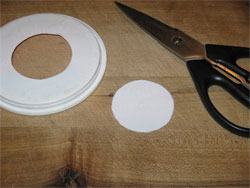
3.) Draw lines on your circle, directly through the center. You’ll want 12 lines. (Note that this isn’t written in stone. If you make a small button, you may want only 8 sections; for a large button, you may want 14 or more.) You’ll see that my lines aren’t entirely even. This isn’t ideal, but it’s not completely critical.
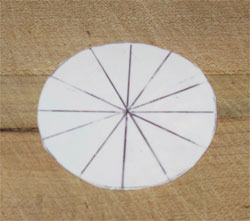
4.) Cut a little V out of each section, using the lines as a guide.
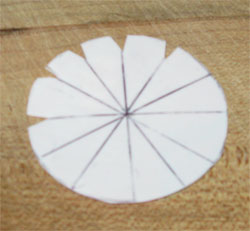
5.) Number the sections of your template, as if it were a clock. Carefully poke a hole in the center of the template. You can use the point of your compass or a sharp needle – your yarn needle isn’t sharp enough.
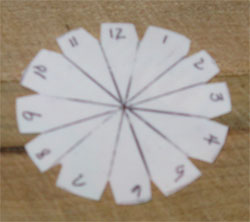
6.) Cut about 4 yards of yarn (I’m using and 8/4 cotton for my sample), and thread it through the yarn needle. Now thread it through the template, from the underside up to the side you’ve numbered. Leave a tail of about 4″. You’ll be working with a single strand of yarn from here through step 9.
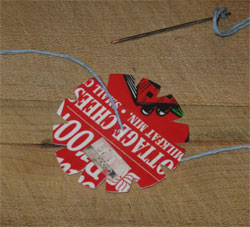
7.) Your yarn is coming up through the center. (From here on when I refer to the slits, I’ll use the number to the right of the slit. Refer to the picture to see what I mean.) Now bring your yarn over the top of the template and through slit 12. Bring it behind the template and back to the front through slit 1. Carry it directly across the template to slit 7.
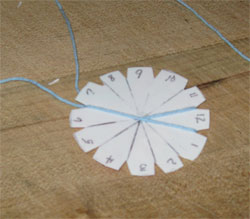
8.) Continue wrapping in this pattern: behind the template and up at 8, across to 2. Behind 2 to 3, up at 3, across to 9. Behind 9 to 10, up at 10, across to 4. Make one complete rotation around your template this way, making sure to cross the center of the template every time you go across the front.

The back will look like this. (Actually, this is after mine is wrapped twice. I forgot to take a picture of the back earlier on in the process.)
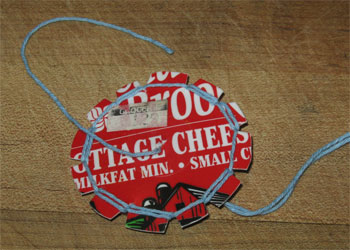
9.) Go around again, following the same pattern with your yarn.
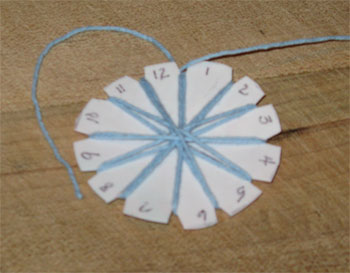
Now you have to make a decision. Should you go around a third time or not? The answer really depends on the size of your yarn and the size of your template. I decided to go around mine a third time, resulting in 3 threads in each of the slits of my template. These 3 threads form spokes.
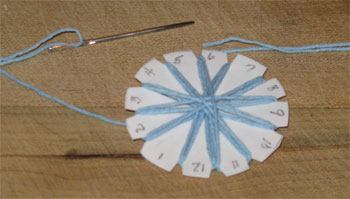
10.) Now you’ll start wrapping those yarn spokes. To begin, move your yarn needle to the center of the yarn, so that you will be working with a double strand of yarn from this point forward. If you followed the same pattern of making the spokes as I did, you’ll end up with your yarn coming up through slot 6. So go across the template to spoke 12. (If you didn’t end on 6, simply adjust by going directly across the template to the opposite number.) Go under spoke 12 with your needle and pull your doubled yarn through. Tuck the loose end under the center of your work.
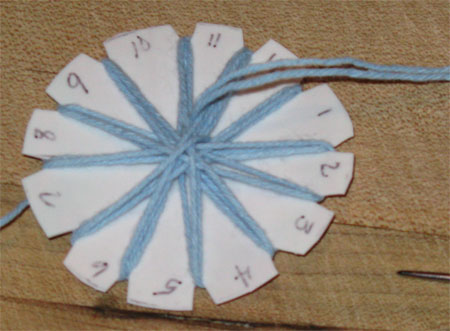
11.) Now go back under spoke 12 and also under spoke 11. The first pic below shows what your work will look like with 2 wraps done. The second pic below shows what your needle will be doing when it’s going under 2 spokes. Again, I forgot to take a picture of this step earlier. Be sure you’re going under all the threads in each spoke, not just one or two of them.


12.) This is rather like an embroidery back stitch. Every time you’ll go back under the last spoke and under the next spoke. Keep doing this until you get all the way around, back to spoke 12. (You’ll have gone under both 1 and 12.)
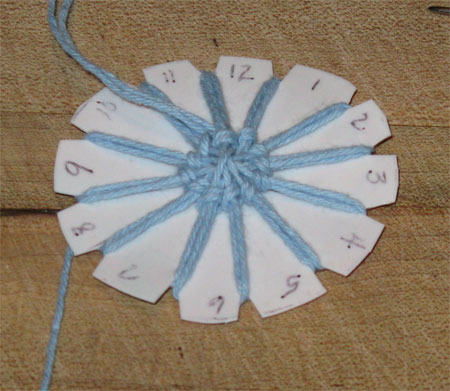
14.) Keep going around until your template is pretty full. If you’re running out of yarn, don’t panic. Simply push the needle with the yarn on it down through the center hole of your template from front to back. Now thread more yarn onto your needle, and poke it up through the center from the bottom, keeping another tail on the backside. Be sure you’re working with your new thread doubled.

While you’re wrapping, watch out for these errors:
catching the yarn on the edge of the template…

…or having one loop of your yarn too loose.

15.) So now your spokes are all wrapped and your template is filled with yarn. It’s time to remove the template. One at a time, gently bend one edge of the template up a little bit and slip the yarn from the back of the template off.
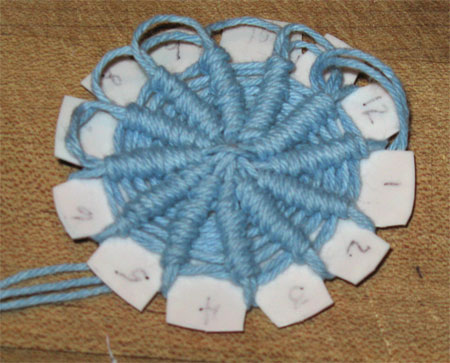
Keep going around the template until all your back loops are loose. Your button will have a daisy-like appearance at this point.

16.) Now gently pull the button off the template, pulling your initial 4″ end of thread through the center hole.
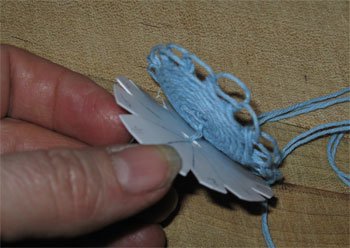
Here’s a front and back shot of your button at this point.

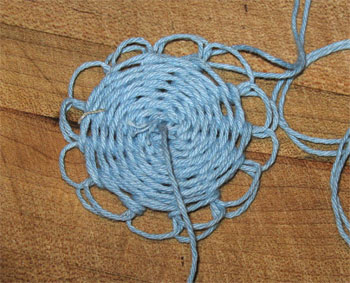
17.) Now choose the button you’ll use for your base. It can be metal, plastic or wood. It can be a button with holes or a button with a shank. It can be old and ugly, as long as it’s not dirty or rusty. Your button should be at least half the size of your yarn daisy. Set the button aside for the moment.
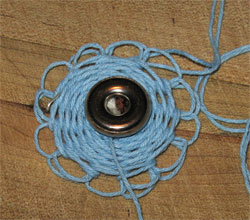
18.) Starting on the outer loop that’s closest to your needle, go down through 1 loop and up through the next. This is like an embroidery running stitch.
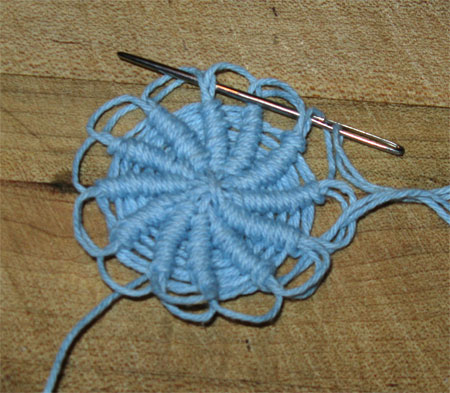
19.) Go all the way round with those up and down running stitches till you get back to where you started. Don’t pull anything tight — keep it loose.
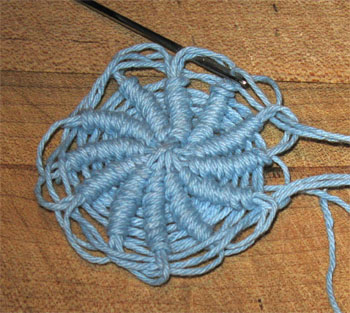
20.) Now flip the yarn over, and hold the button in the middle of the back of the yarn daisy. Tuck that beginning 4″ tail under the button.
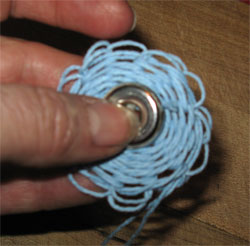
21.) Here’s the exciting part. Gently pull on the yarn you threaded through those daisy loops, and your yarn button will start to take shape, forming over the base button.
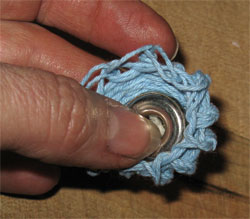
Keep pulling until the yarn closed around the base button.
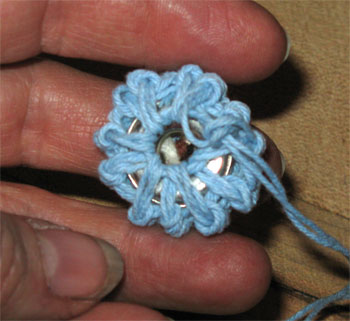
Pull more until the yarn is quite snug. Finish the yarn by tying a knot. Leave the end.
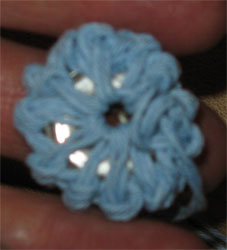
Flip it over, make any adjustments you need to center everything, and YOU ARE DONE! You can use the remainder of the yarn to sew the button to your garment.
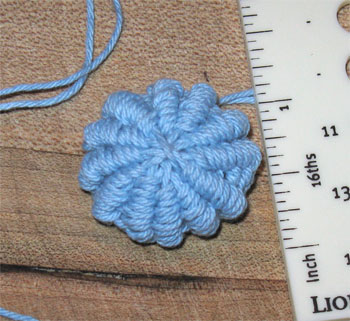
Congratulations on your lovely yarn button!
You can see that using a 2 1/4″ template and a medium weight yarn, I ended up with a button that’s about 1″ in diameter.
Once you’ve got the hang of it, you can add your own touches to your button – changing colors, threading a few little beads in the center, whatever floats your boat.
If my instructions aren’t clear, or if you have any questions, don’t hesitate to ask. After you’ve made a button, I’d love to see a picture of it!
Join the V7N Challenge – learn something new every day



Oh My! THANK YOU! I’m very glad you made this tutorial! THANKS! I’m very excited to try this!
Happy to help, Nancy. Let me know how your button(s) turn out!
HI
I found this tutorial while trying to find some back history on Yorkshire Buttons. I live in Yorkshire UK and found this technique on some Dorset Button sites. I make them without a solid frame inside either left soft (they can be stitched flat) or a little stuffing to hold the shape. Made in machine embroidery thread on a very small loom they make wonderful buttons on baby garments as they as soft when laid on.
So far there seems very little history as to why it is called Yorkshire or if there was a button industry here. I wonder if the lady who passed on the technique remembers where she got it from, if so I would love to know.
Thank you for passing it on and I am really glad I found your site.
Thanks for this info, Tanya! I do know that Cathy, the woman who taught me this technique, learned it from her mother, Isa. Both Isa and Cathy are from Scotland; Cathy didn’t come to the US till she was a young adult. I will pass your info on to her and see if she knows anything else.
Thanks, Betsy & Cathy. I’ve happily modified the post to include Isa’s name!
Excellent job on the directions, Peg!
Hi Peg
Nice job. If you do more of this could you please call it Isa’s Button. as that was my mother’s name and it is her button. Thanks, Cathy
[…] Margaret Cherre Member Latest Blog:How To Make A Yarn Button […]
Thanks for the compliments Liz, Judy, & LeeAnna. I hope you make buttons and share them with the rest of us!
I love this! Thanks for sharing the “how-to”. Your directions are very clear.
Great buttons Peg – and wonderful instructions…even better than doing a video as your way lets learners work step by step with you but going at their own speed.
Thanks so much for the detailed instructions. I want to give this a try.